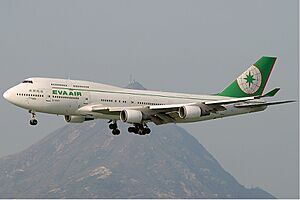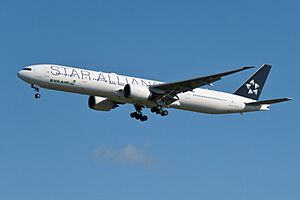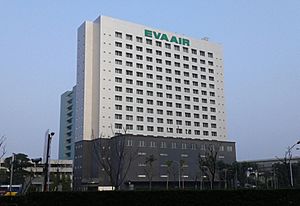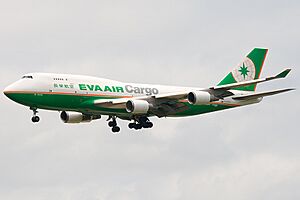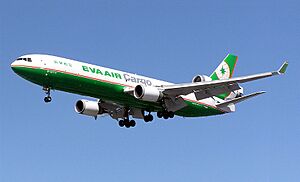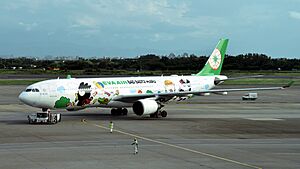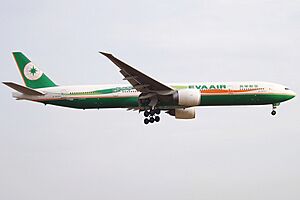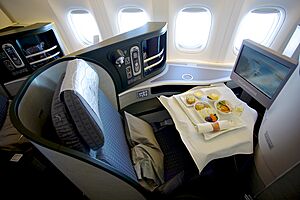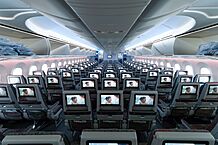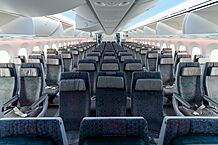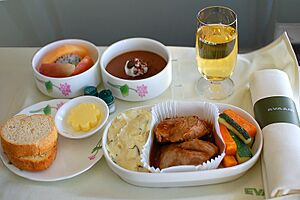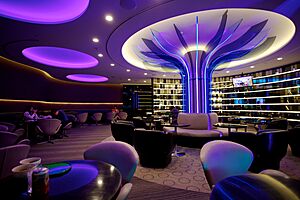EVA Air facts for kids

An EVA Air Boeing 787-10
|
|
| Founded | 8 March 1989 |
|---|---|
| Commenced operations | 1 July 1991 |
| Hubs | Taipei–Taoyuan |
| Focus cities |
|
| Frequent-flyer program | Infinity MileageLands |
| Alliance | Star Alliance |
| Subsidiaries | UNI Air |
| Fleet size | 84 |
| Destinations | 58 |
| Parent company | Evergreen Group |
| Headquarters | 376, Hsin-Nan Rd., Sec. 1, Luzhu, Taoyuan City, Taiwan |
| Key people | |
| Revenue | NT$127,142,232,000 |
| Operating income | NT$17,028,465 |
| Net income | NT$8,146,909,000 |
| Profit | NT$7,091,299,000 |
| Total assets | NT$294,048,935,000 |
| Total equity | NT$87,936,555,000 |
| Employees | 10,377 (31 December 2022) |
| EVA Air | |||||||||||||
|---|---|---|---|---|---|---|---|---|---|---|---|---|---|
| Traditional Chinese | 長榮航空 | ||||||||||||
| Simplified Chinese | 长荣航空 | ||||||||||||
| Literal meaning | Evergreen Airlines | ||||||||||||
|
|||||||||||||
EVA Air is a big international airline based in Taoyuan City, Taiwan. It's one of the largest airlines in Taiwan, flying passengers and cargo to over 40 places around the world. These destinations are in Asia, Australia, Europe, and North America. EVA Air is known for its international flights and does not fly domestic routes within Taiwan.
The airline is highly rated, earning a 5-star rating from Skytrax. EVA Air is part of the Evergreen Group, a large company that also deals with shipping. Besides flying, EVA Air also handles air cargo, airline food, ground services for planes, and aircraft engineering. Its cargo division, EVA Air Cargo, works closely with Evergreen's global shipping network. For flights within Taiwan and to nearby places like Macau and China, EVA Air has a subsidiary airline called UNI Air.
EVA Air uses a mix of Airbus and Boeing planes. These include the Airbus A330, Airbus A321, Boeing 777, and Boeing 787 for passenger flights. They also use Boeing 777 planes just for cargo. EVA Air was a pioneer in offering a special "Premium Economy" class, which they first introduced in 1991.
Contents
History of EVA Air
Starting the Airline
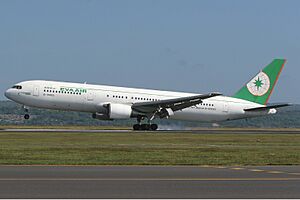
In September 1988, the chairman of Evergreen Marine, Chang Yung-fa, announced plans to start Taiwan's first private international airline. This was possible because the Taiwanese government decided to allow more private companies to operate airlines. To start an international airline, a company needed global experience and a lot of money.
EVA Airways Corporation officially began in March 1989. It was almost called Evergreen Airways, but that name was too similar to another cargo airline. In October 1989, EVA Air ordered 26 planes from Boeing and McDonnell Douglas, including Boeing 747-400s and MD-11s.
Flights started on July 1, 1991, using three Boeing 767-300ER planes. These planes had both business and economy class seats. The first places EVA Air flew to from Taipei were Bangkok, Seoul, Jakarta, Singapore, and Kuala Lumpur. By the end of 1991, EVA Air also flew to other cities in East Asia and its first European city, Vienna.
Growing in the 1990s
In 1992, EVA Air received its first Boeing 747-400 planes. In December of that year, they launched their special "Economy Deluxe" class on flights to Los Angeles. This was a new type of seating that was better than regular economy. EVA Air's "Economy Deluxe" (later called "Elite Class") was very popular. These 747s had 104 "Economy Deluxe" seats, along with first, business, and economy classes. By 1993, EVA Air added flights to Seattle, New York, Bangkok, and Vienna using the Boeing 747-400.
By 1994, EVA Air flew to 22 places worldwide and carried over 3 million passengers each year. In 1995, the airline made its first profit, which was a year earlier than expected. EVA Air grew quickly and gained more passengers because of its excellent safety record. In 1997, EVA Air received important safety and quality certifications.
EVA Air Cargo, the airline's freight service, started in April 1995. They used McDonnell Douglas MD-11 cargo planes to fly to places like Taipei, Singapore, Penang, San Francisco, New York, and Los Angeles. Before this, cargo was mainly carried in the belly of passenger planes.
In the mid-1990s, EVA Air also started flying within Taiwan. They bought parts of other airlines like Makung International Airlines and Great China Airlines. On July 1, 1998, these airlines merged with EVA Air's existing domestic flights to form UNI Air. UNI Air became EVA Air's airline for short flights within Taiwan, mainly from Kaohsiung.
Changes in the Early 2000s
In 2000, EVA Air decided to update its fleet of long-haul planes. They were one of the first airlines to order the Boeing 777-300ER. They also ordered the A330-200 in January 2001. The Boeing 777s were for flights to the United States and Europe, while the Airbus A330s were for shorter flights in Asia.
In 2001, EVA Air started selling its shares on the Taiwan Stock Exchange. In 2002, the airline made some internal changes to improve its operations. The SARS outbreak in 2002–2003 affected flights in Southeast Asia, but long flights to North America, Japan, and Europe were less impacted.
In 2004, EVA Air ordered more Boeing 777-300ERs. The first Boeing 777-300ER started flying in July 2005 and became EVA Air's main long-haul plane. With these new planes, EVA Air updated its cabins. They introduced lie-flat seats in their "Premium Laurel" business class and improved their premium economy to the new "Elite Class." By December 2005, EVA Air flew to 40 passenger destinations worldwide.
Joining Star Alliance and More Growth
In 2007, EVA Air started nonstop flights from Taipei to New York (Newark Liberty International Airport) using its new Boeing 777-300ERs. They also stopped passenger service to Paris for a short time but brought it back in 2009. In 2008, they began increasing direct flights to China.
The airline faced challenges with rising fuel prices in 2007 and 2008, which led to some losses. In response, they cut costs and reduced some flights. However, EVA Air returned to making a profit in early 2009. In August 2010, Travel+Leisure magazine named EVA Air one of the top 10 international airlines.
In March 2010, EVA Air started flights to Toronto. In November 2010, they began nonstop flights between the city airports of Taipei Songshan and Tokyo Haneda. In 2010, Chang Kuo-wei, the son of the founder, became EVA Air's president, and the airline saw increased sales and profits.
On March 27, 2012, EVA Air announced it would join Star Alliance, a large group of airlines. On June 18, 2013, EVA Air officially became a full member of Star Alliance. This means passengers can easily connect to many more destinations around the world.
In October 2014, EVA Air announced plans to add new routes to Houston in 2015 and Chicago in 2016. They also planned to increase flights to North America. In October 2015, EVA Air announced it would buy up to 24 Boeing 787 planes and two more 777-300ER jets.
Recent Updates
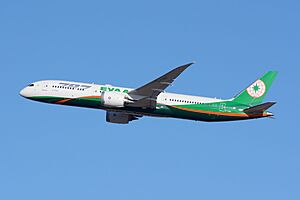
In November 2015, EVA Air showed off a new design for its planes. In January 2016, the founder of Evergreen Group, Chang Yung-fa, passed away. His son, Chang Kuo-Wei, took control but was later replaced by Lin Pang-Shui in March 2016. Chang Kuo-Wei later started a new airline called Starlux Airlines.
In June 2016, EVA Air was one of only eleven airlines to receive a Skytrax 5-star rating, showing its high quality. In November 2017, EVA Air introduced new uniforms for its staff, designed by a famous fashion house.
On October 2, 2018, EVA Air received its first Boeing 787-9 Dreamliner. They have ordered 20 of the larger 787-10s. In June 2019, EVA Air received its first Boeing 787-10 Dreamliner.
How EVA Air Works
Management and Headquarters
EVA Air's main offices, called the EVA Air Building, are in Luzhu, Taoyuan City. The airline is mostly owned by private companies and individuals. The main owners are Evergreen Marine Corporation and the Evergreen Group founder, Chang Yung-fa.
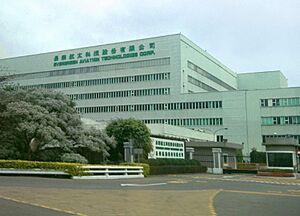
Plane Designs and Uniforms
Name and Logo
The name "EVA" comes from "Evergreen Airways." It's always spelled in capital letters and pronounced "E-V-A." The airline uses the logo of its parent company, which is green with an orange edge. The orange edge was removed in the current logo.
Livery and Uniforms
The standard EVA Air plane design uses dark green, which means strength, and orange, which means new ideas in technology. The tail logo, a globe, shows stability and reliability. The first design was updated in 2002 with a larger font and more green color. In late 2015, EVA Air changed the design again, using dark green on the bottom of the plane and removing the orange line on the tail.
Since 2003, EVA Air staff have worn dark green dresses with short jackets. Chief pursers have orange details, while flight attendants have green trim.
Marketing Slogans
EVA Air has used different slogans over the years. Here are some of them:
- Flying into the Future (2016–present)
Different Parts of EVA Air
EVA Air Cargo
EVA Air Cargo started at the same time as the passenger airline. It has offices in Europe, Asia, and North America. They transport high-tech equipment and special items like museum art and live animals. EVA Air wants to earn half of its money from cargo and half from passenger flights. Their cargo planes include Boeing 747-400s and MD-11s, and they also use space in passenger planes.
In 2003, EVA Air Cargo opened its European Cargo Center in Brussels. In 2006, they opened their Southern China Cargo Center in Hong Kong. By 2007, EVA Air Cargo had 43 weekly cargo flights to cities like London, Vienna, Brussels, and several US cities. They also work with other airlines for cargo, like British Airways World Cargo.
By 2004, EVA Air Cargo was one of the top 10 largest air freight companies in the world. In 2008, they helped transport two Chinese pandas to the Taipei Zoo.
Maintenance and Support
EVA Air also has facilities for training pilots and flight attendants. They have divisions for catering (Evergreen Sky Catering) and ground support (Evergreen Airline Services). Since 1998, EVA Air has worked with General Electric to run Evergreen Aviation Technologies Corporation (EGAT). This company provides services for repairing and updating planes for EVA Air and other airlines.
Where EVA Air Flies
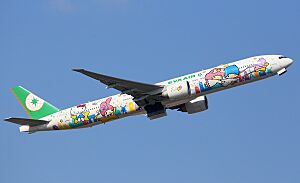
Most EVA Air flights start from Taoyuan International Airport, which is its main hub near Taipei, Taiwan. At this airport, EVA Air flights are mainly in Terminal 2. EVA Air and its subsidiary UNI Air also fly many flights from Kaohsiung International Airport. Bangkok (Suvarnabhumi Airport) is another important city for EVA Air, with flights connecting to its European destinations.
In the past, Taiwan's political situation made it harder for Taiwanese airlines to fly directly to some countries. So, EVA Air used Hong Kong, Bangkok, and Macau as connecting points. However, in December 2008, EVA Air started regular direct flights to China.
A flight to Houston (George Bush Intercontinental Airport) started in June 2015. Service to Chicago (O'Hare International Airport) began on November 2, 2016. These were part of a plan to increase flights to North America.
EVA Air also started a new year-round service to Istanbul on March 5, 2016, but this route was later canceled. They also launched daily flights to Cebu, Philippines, on March 27, 2016. In July 2018, EVA Air expanded its flights to Southeast Asia by offering daily flights to Chiang Mai.
In November 2024, EVA Air announced that it will start flights from Taipei to Dallas on November 3, 2025. Dallas will be the airline's seventh destination in the United States.
Partner Airlines
EVA Air has agreements with other airlines to share flights. This means you can book a flight with EVA Air but fly on a plane operated by one of their partners. These partners include:
- Aegean Airlines
- Air Canada
- Air China
- Air India
- Air Macau
- Air New Zealand
- All Nippon Airways
- Asiana Airlines
- Avianca
- Bangkok Airways
- Copa Airlines
- Hainan Airlines
- Hong Kong Airlines
- Juneyao Air
- LOT Polish Airlines
- Shandong Airlines
- Shenzhen Airlines
- Singapore Airlines
- Thai Airways International
- Turkish Airlines
- Uni Air (This is their own subsidiary airline)
- United Airlines
EVA Air Planes
Current Fleet
As of February 2025, EVA Air uses these planes:
| Aircraft | In service | Orders | Passengers | Notes | ||||
|---|---|---|---|---|---|---|---|---|
| R | C | W | Y | Total | ||||
| Airbus A321-200 | 17 | — | — | 8 | — | 176 | 184 | All to be retired and replaced by Airbus A321neo in 2032. |
| Airbus A321neo | — | 18 | TBA | Deliveries between 2029 and 2032. To replace Airbus A321-200. |
||||
| Airbus A330-300 | 9 | — | — | 30 | — | 279 | 309 | To be retired and replaced by Boeing 787-9 in 2029. |
| Airbus A350-1000 | — | 24 | TBA | To replace older Boeing 777-300ER. Deliveries between 2026 and 2030. |
||||
| Boeing 777-300ER | 33 | — | 38 | — | 64 | 221 | 323 | Three aircraft to be converted into freighters in 2025. Older aircraft to be retired and replaced by Airbus A350-1000. |
| 39 | 56 | 238 | 333 | |||||
| 258 | 353 | |||||||
| Boeing 787-9 | 4 | — | 26 | — | — | 278 | 304 | Orders changed from Boeing 787-10. Nine to delivered with Premium Economy seats, existing four to be refurbished in the future. Additional five aircraft to be delivered between 2025 and 2027. To replace Airbus A330-300. |
| 3 | 6 | 28 | 224 | 278 | ||||
| Boeing 787-10 | 12 | 5 | 34 | — | — | 308 | 342 | Originally ordered 24 in 2015. |
| EVA Air Cargo fleet | ||||||||
| Boeing 777F | 9 | — | Cargo | Orders changed from Boeing 787-10. | ||||
| Boeing 777-300ER/SF | — | 3 | Cargo | Converted from passenger aircraft. Delivery starts from 2025. |
||||
| Total | 87 | 51 | ||||||
Special Plane Designs
In October 2005, EVA Air started a fun project with the Japanese company Sanrio to create "Hello Kitty Jets." These planes feature the popular Hello Kitty characters on the outside. A year later, they launched a second Hello Kitty Jet. These planes have Hello Kitty designs everywhere, even inside! They were used for flights to Japan and Hong Kong.
The first Hello Kitty design was retired in 2009. But in 2011, EVA Air brought them back with new designs to celebrate their 20th anniversary. They ordered new Airbus A330-300s painted with new Hello Kitty themes like Hello Kitty with Magic Stars and Hello Kitty Loves Apples.
In 2012, two more Hello Kitty jets were added: Hello Kitty Speed Puff and Hello Kitty Happy Music. In 2013, a sixth Hello Kitty jet, Hand in Hand, was introduced on a Boeing 777-300ER. This plane featured all the main characters from the Sanrio family. In 2015, the seventh and final Hello Kitty jet, Shining Star, was added, also on a Boeing 777-300ER.
In 2017, some of the older Hello Kitty jets were re-themed with new characters like Badtz-Maru and Gudetama. In November 2024, an Airbus A321-200 was painted in the Hello Kitty Pinky jet design.
In July 2006, one of EVA Air's new Boeing 777-300ERs was shown at the Farnborough Airshow. This plane had a special "Rainbow" design. The first three EVA Air Boeing 777s had this design.
For the 2010 Taipei International Flora Exposition, EVA Air created a flower-inspired design for its A330-200 planes. They also had flower-themed meals on board.
Retiring Older Planes
As new 777s arrived, older 747s were gradually retired. On January 5, 2015, EVA Air retired its 747-400M Combi plane. In 2016, EVA announced that the last 747-400 passenger flight would be in mid-May 2017. EVA Air retired the Boeing 747-400 passenger planes from its fleet on August 21, 2017. The remaining 747 cargo planes were retired by 2019.
Services on Board
Hello Kitty Flights EVA Air has operated Hello Kitty-themed flights since 2005. These flights are very popular, with many passengers choosing them.
Checking In
At Taiwan Taoyuan International Airport, EVA Air has self-service check-in kiosks. These allow passengers to check in and print their boarding passes easily. These kiosks are also available at Taipei Songshan Airport, Los Angeles, Tokyo, and Osaka.
Onboard Experience
EVA Air offers different classes on its long-haul flights: "Royal Laurel" or "Premium Laurel" (business class), Premium Economy Class, and Economy Class. All cabins have satellite phones, entertainment systems with movies and music, and SMS service. Some Boeing 777 planes also have special mood lighting. Shorter flights within Asia have a business class too.
In 2007, EVA Air updated its Boeing 747-400 planes to include the latest seating. In early 2012, EVA Air introduced a new "Royal Laurel" business class. These seats can lie completely flat, like a bed. This new class was first used on Boeing 777-300ER flights between Taipei and New York in June 2012.
Cabin Classes
EVA Air has five types of cabins. The newest is Royal Laurel Class, introduced in May 2012 on redesigned Boeing 777-300ER planes. These cabins have 38 lie-flat seats that are very wide. Each seat has power outlets for laptops and connectors for USB and iPods. The Royal Laurel class seats are arranged so everyone has direct aisle access. This cabin is available on all Boeing 777 flights. The Boeing 787 also has Royal Laurel Class seats, designed by BMW Group. These seats are 584 mm (23 in) wide and recline into flat beds that are 1,930 mm (76 in) long.
Premium Laurel Class is EVA Air's older business class. It was introduced in 2003 on the A330-200. These seats can recline into an angled lie-flat bed. Power outlets are available.
Business Class is for shorter flights on the A321. It has eight seats with a 10.6-inch entertainment system and power outlets.
Premium Economy Class is a special cabin on the Boeing 777. It has wider seats and more legroom than economy. The seats are similar to short-haul business class seats, with a footrest and adjustable headrests. Passengers in Premium Economy also receive an amenity kit on most flights.
Economy Class is available on all EVA Air planes. These seats have personal entertainment screens, sliding seat cushions, and adjustable headrests. Each seat also has a satellite telephone that can be used with a credit card. On some Boeing 777s and 787s, the seats are arranged 3-3-3. On the A321, it's 3-3, and on A330s, it's 2-4-2. A321 Economy class does not have personal entertainment screens, only overhead screens.
Newer Economy and Premium Economy cabins on 777-300ER planes have improved entertainment systems and USB and 110 V AC power ports at each seat. The seat-back screens are larger. In 2018, EVA Air changed the name "Elite Class" to "Premium Economy Class."
In-flight Entertainment
EVA Air's entertainment system, Star Gallery, is available in all classes except Airbus A321 Economy. It has 40 movies, games, and over 100 music albums. Programs are mainly in Mandarin and English, with some in Japanese, German, and French.
You can find movies in Sky Hollywood, music in Sky Concert Hall, and entertainment for younger travelers in Kids' World. Since 2005, passengers can also send text messages and emails from their seats.
enVoyage is EVA Air's in-flight magazine, with articles in English, Mandarin, and Japanese. The EVA Air Sky Shop brochure is also available for duty-free shopping.
Food and Drinks
EVA Air offers a variety of meals on its long flights, depending on your seat class, destination, and flight length. You can choose between Western and Eastern meals, and there are also seasonal options. You can ask for special meals when you book, like children's meals, religious meals, or vegetarian meals.
In Royal Laurel Class and Premium Laurel Class, passengers can pre-order special meals, including dishes from Din Tai Fung, a famous Taiwanese restaurant. Royal Laurel cabins on the Boeing 777 also have a refreshment bar and serve European wines.
EVA Air Lounges
EVA Air has special lounges at major airports called EVA Air Lounge. Passengers in Royal Laurel, Premium Laurel, and business class can use these lounges. Also, members of their frequent flyer program (Infinity MileageLands Diamond, Gold, and Silver Card holders) and Star Alliance Gold members can enter.
EVA Air has four main lounges at Taiwan Taoyuan International Airport:
- The Garden is for top-tier members and special credit card holders flying in Royal Laurel/Premium Laurel/Business Class.
- The Infinity is for all eligible passengers, including Royal Laurel/Premium Laurel/Business Class passengers and Star Alliance First/Business Class Passengers.
- The Star is for Infinity MileageLands Gold and Star Alliance Gold members, and business class customers.
- The club by EVA Air is for Infinity MileageLands Silver members and certain credit card holders.
EVA Air also has lounges in Bangkok and Kaohsiung. These lounges usually offer refreshments, business facilities, and entertainment.
Infinity MileageLands Program
Infinity MileageLands is EVA Air's program for frequent flyers. Members earn points based on how far they fly and their class of service. These points can be used for upgrades or free tickets. You can also earn points using certain credit cards, rental car services, and hotels.
Joining the program is free. There are four levels: Green, Silver, Gold, and Diamond. Higher levels offer more benefits, like a special phone line for reservations, extra baggage allowance, and discounts. The program also accepts miles flown on partner airlines and Star Alliance partners like All Nippon Airways and United Airlines.
Shuttle Services
EVA Air offers free shuttle services in the United States and Europe for its customers. For example, in the US, they have shuttles to and from John F. Kennedy International Airport (New York City) and George Bush Intercontinental Airport (Houston).
Safety Record
EVA Air has a very good safety record. It has never had any plane losses or passenger deaths in its history. As of January 3, 2024, EVA Air was ranked number 14 in safety by cntraveler.com. In the 2018 JACDEC Airline Safety Ranking, EVA Air was ranked 15th out of 100 major airlines.
- December 16, 2016: EVA Air Flight 015, a Boeing 777-300ER, was taking off from Los Angeles International Airport. Due to a mistake by air traffic control, the plane was told to turn left instead of right. This caused the plane to fly towards Mount Wilson. The pilots had to quickly climb higher to avoid hitting the mountain. Another plane, Air Canada Flight 788, also had to climb to avoid a problem.
- December 2, 2017: EVA Air Flight 035, a Boeing 777-300ER, was moving on the ground at Toronto Pearson International Airport in the dark. It hit a pole, causing damage to its wing. The flight was canceled.
- June 10, 2023: EVA Air Flight 189, an Airbus A330-300, was leaving Taipei Songshan Airport for Haneda Airport in Tokyo. It accidentally hit the wing of Thai Airways International Flight 683, which was also an Airbus A330-300. The Thai Airways plane had minor damage. This collision caused one of Haneda's runways to close.
See also
 In Spanish: EVA Air para niños
In Spanish: EVA Air para niños


